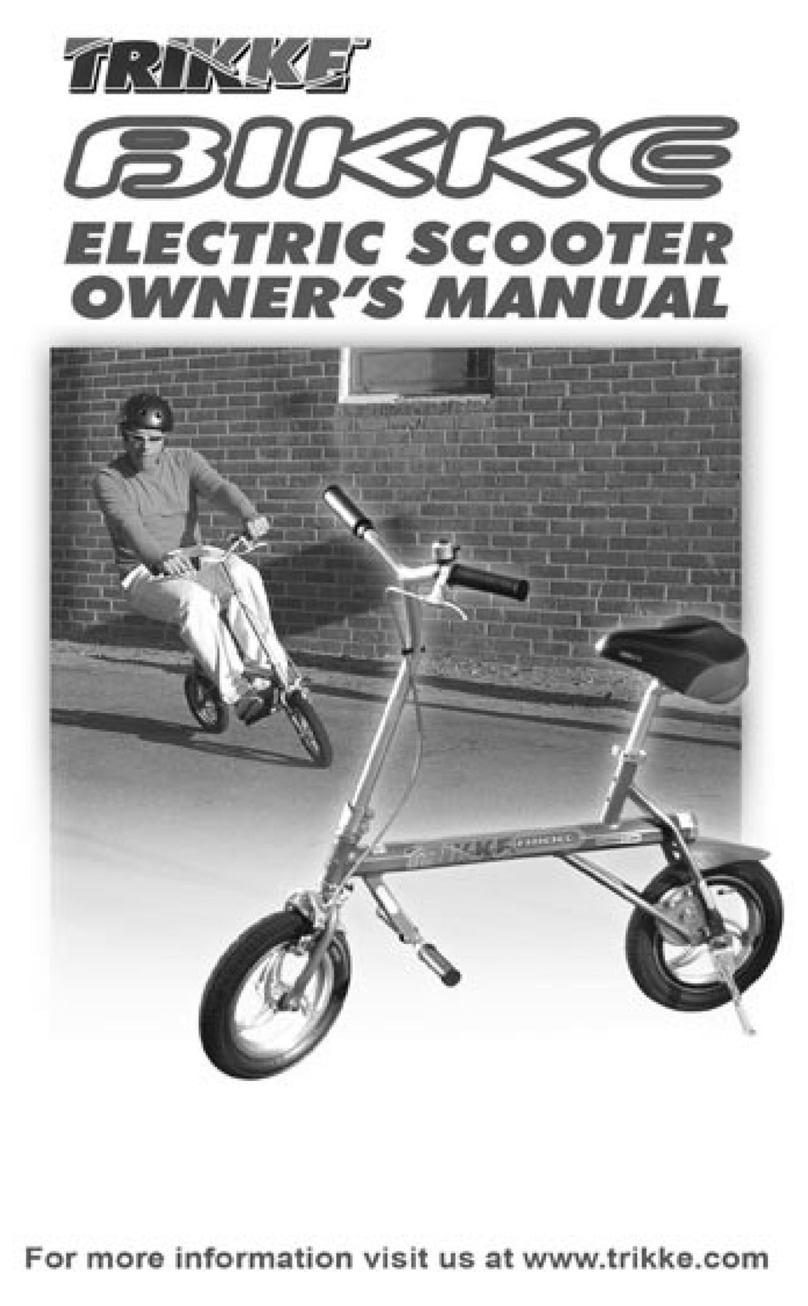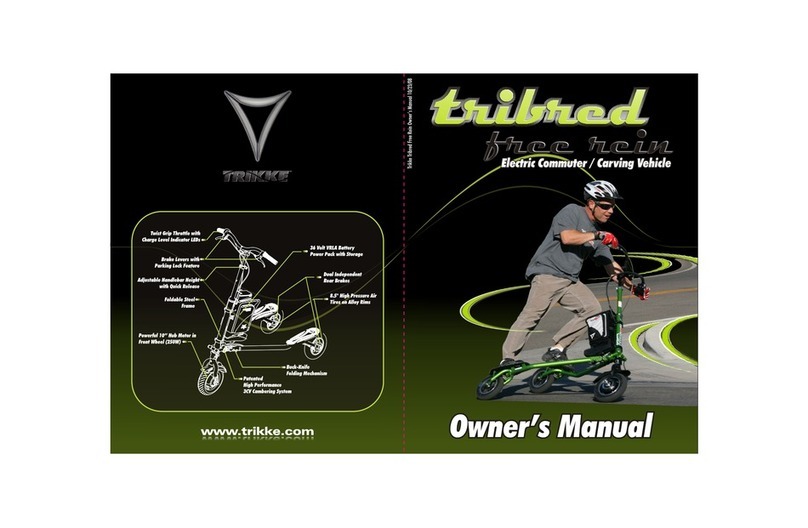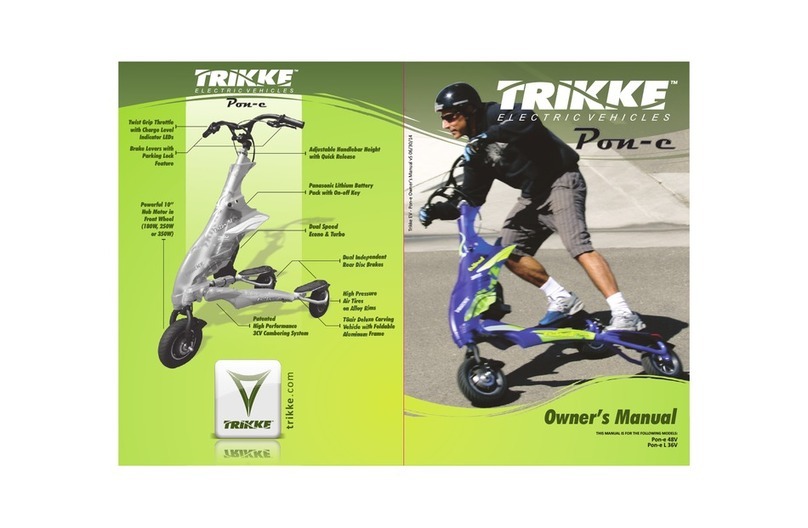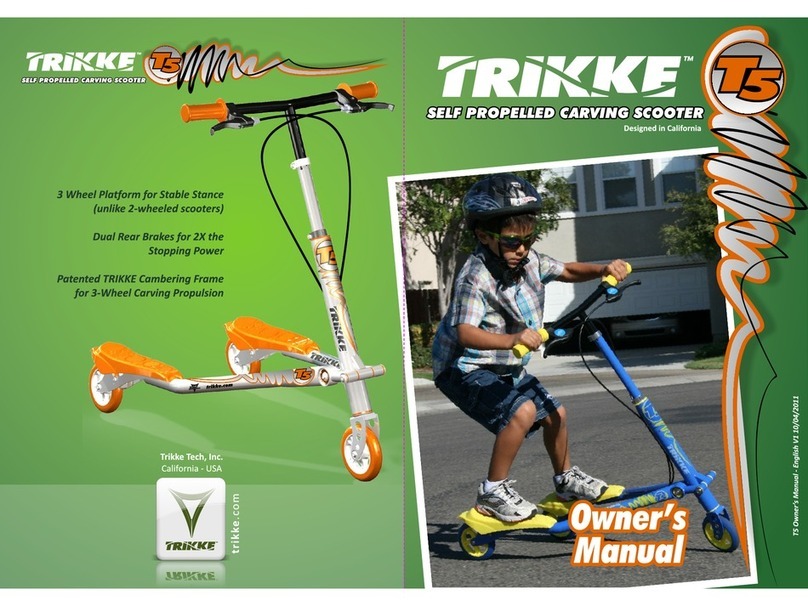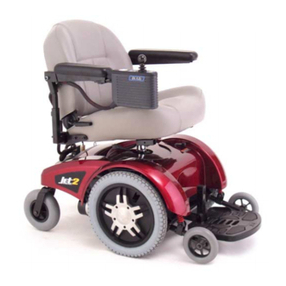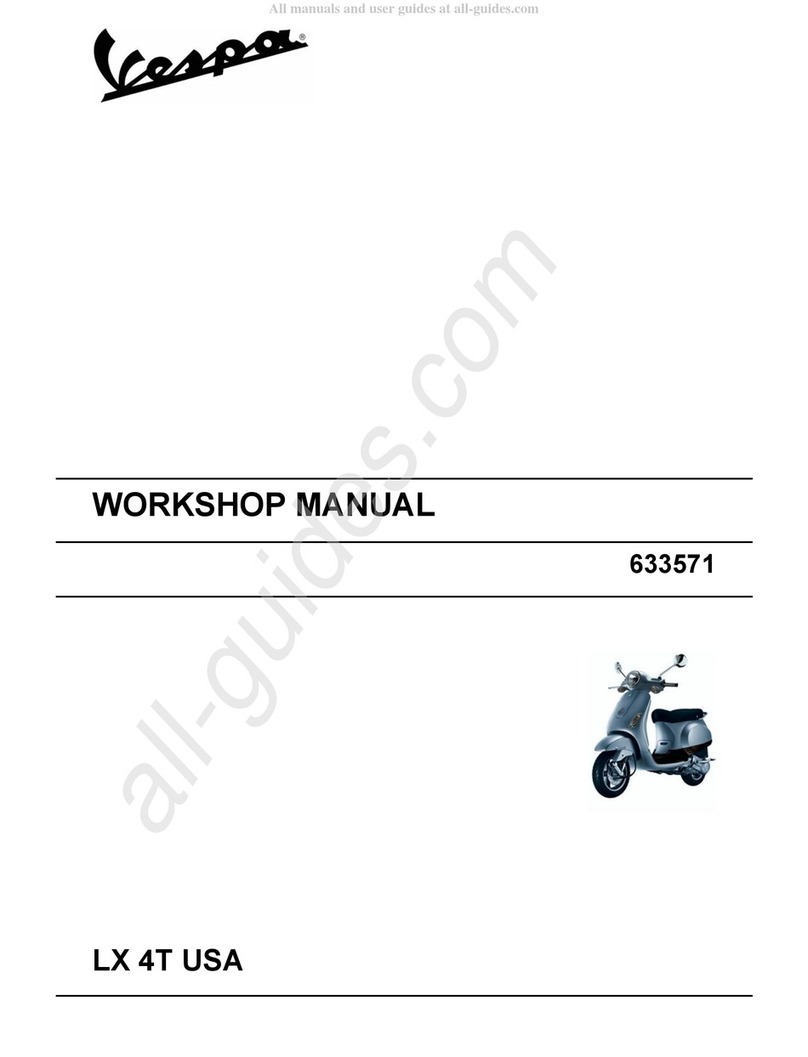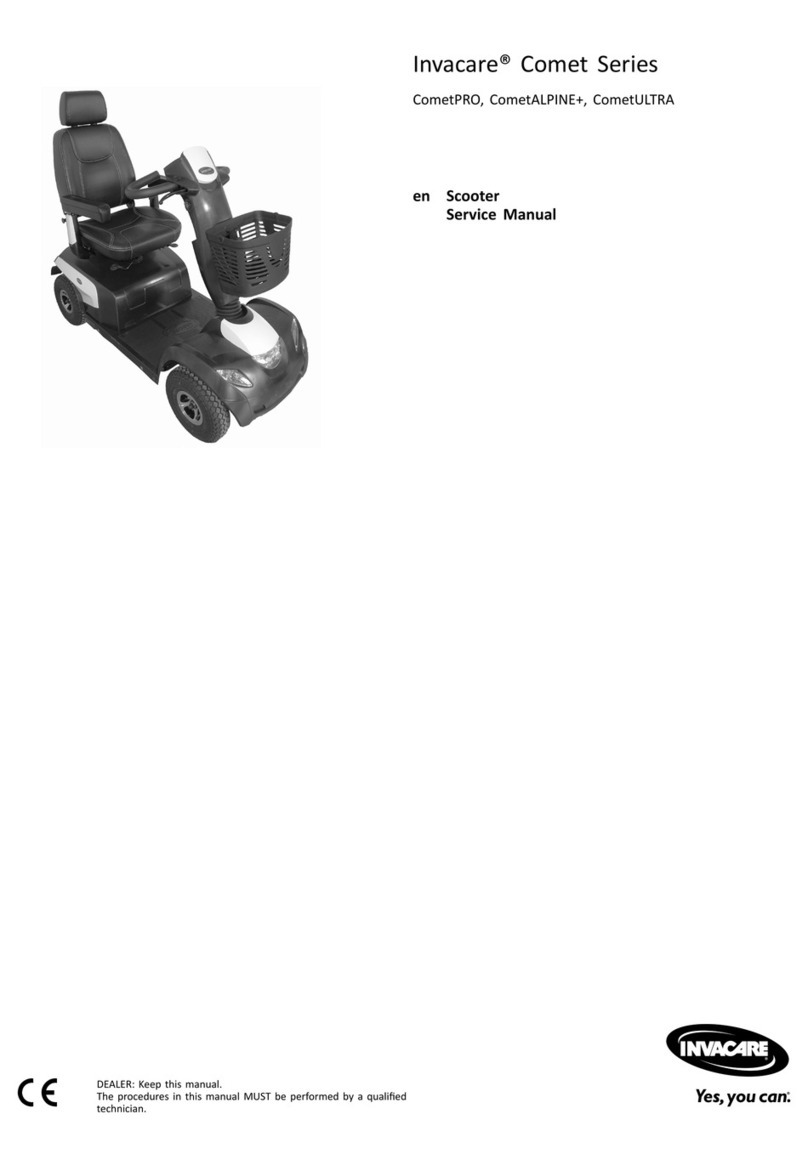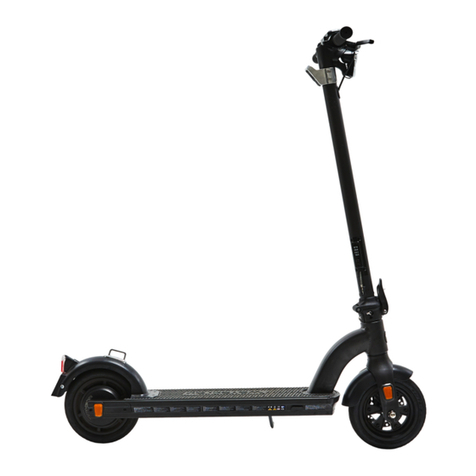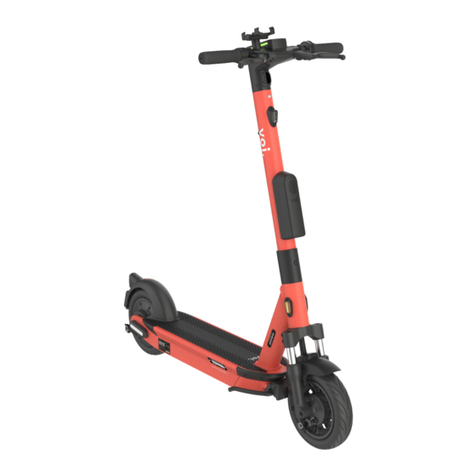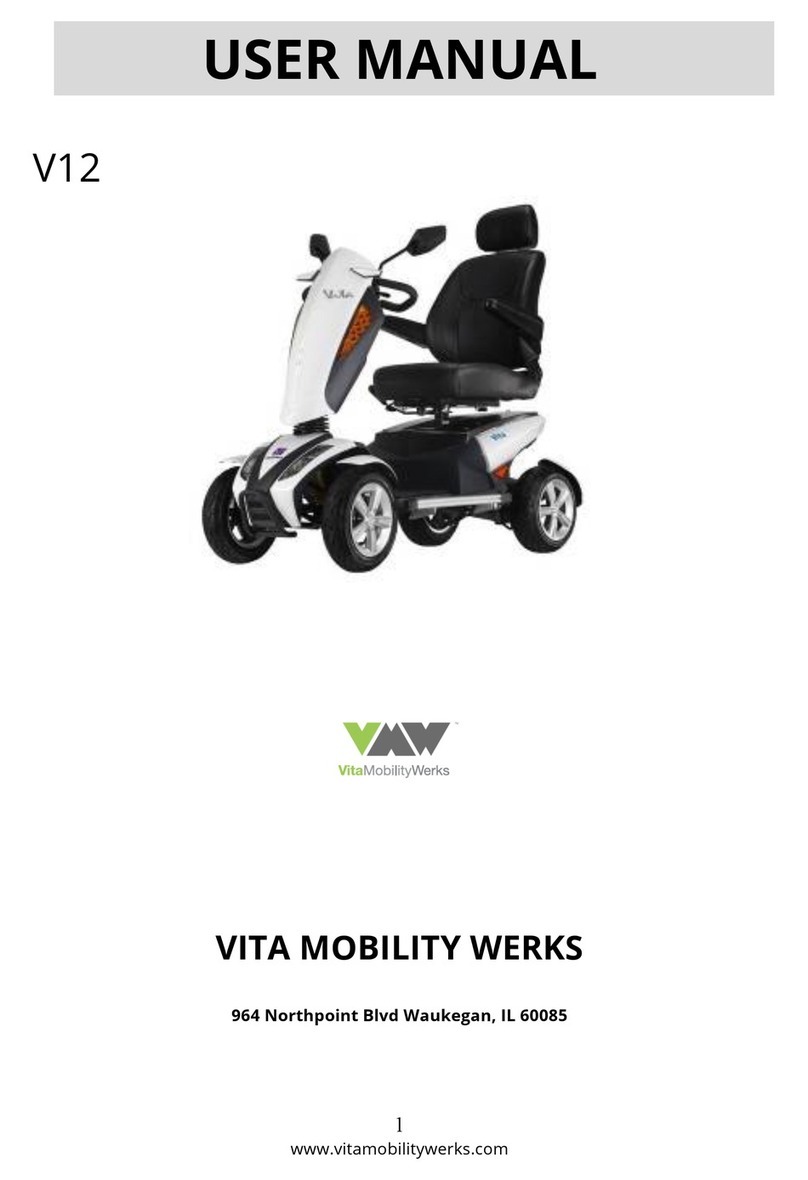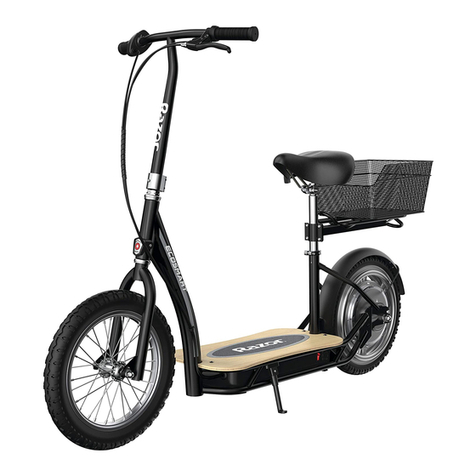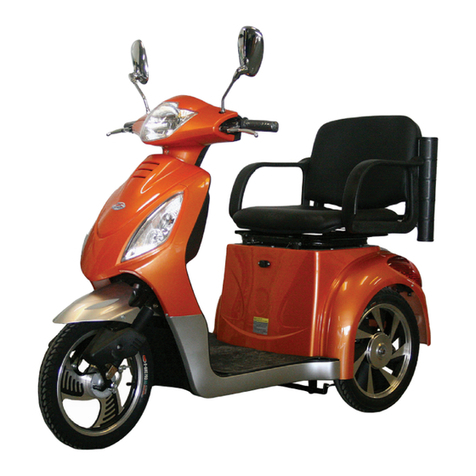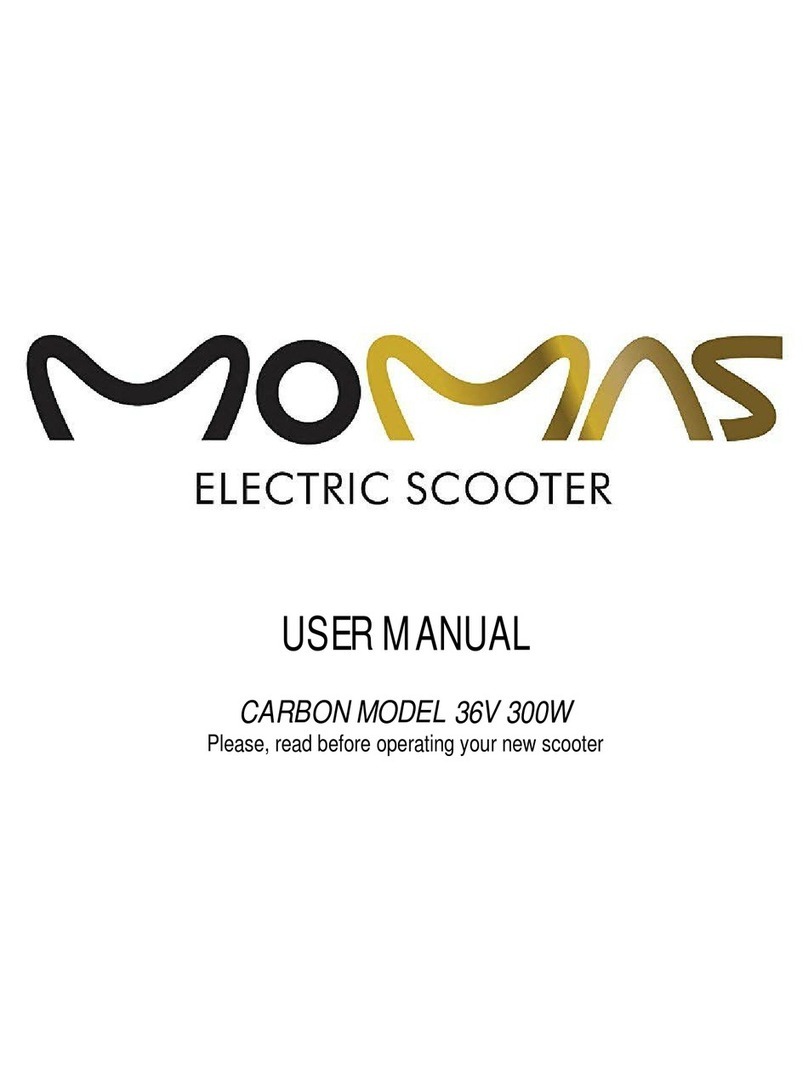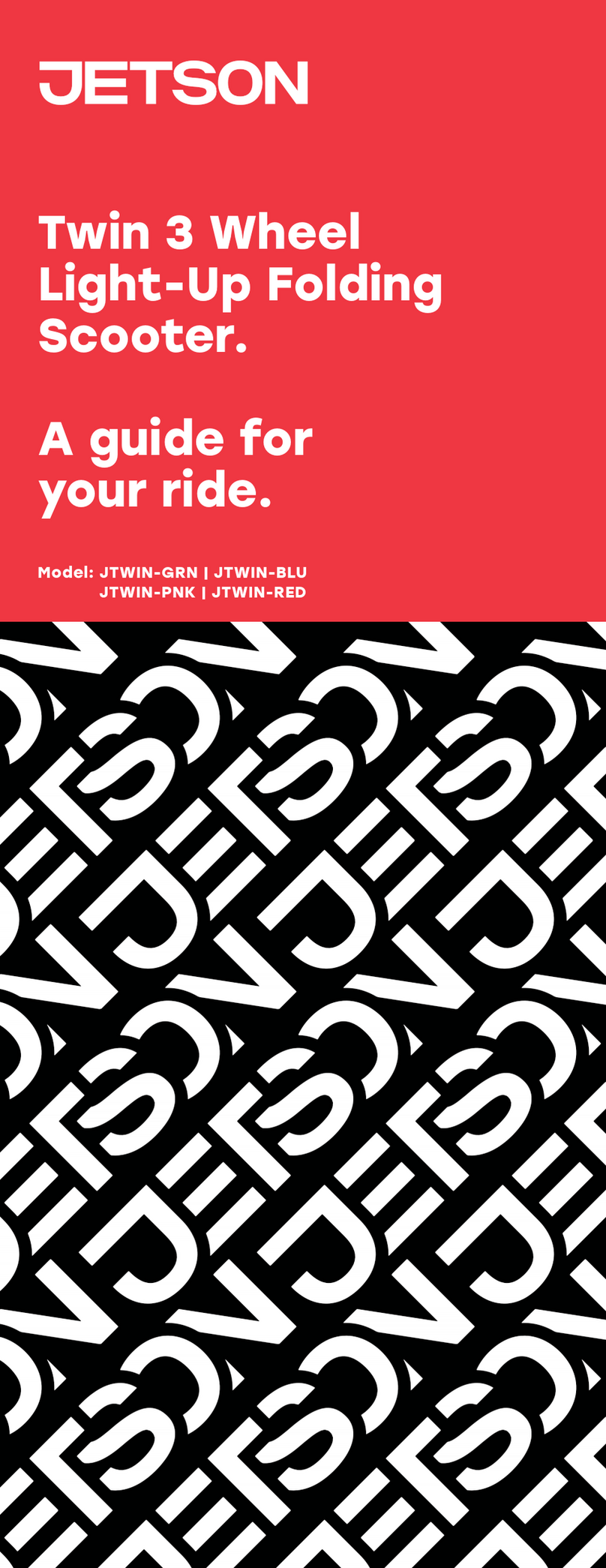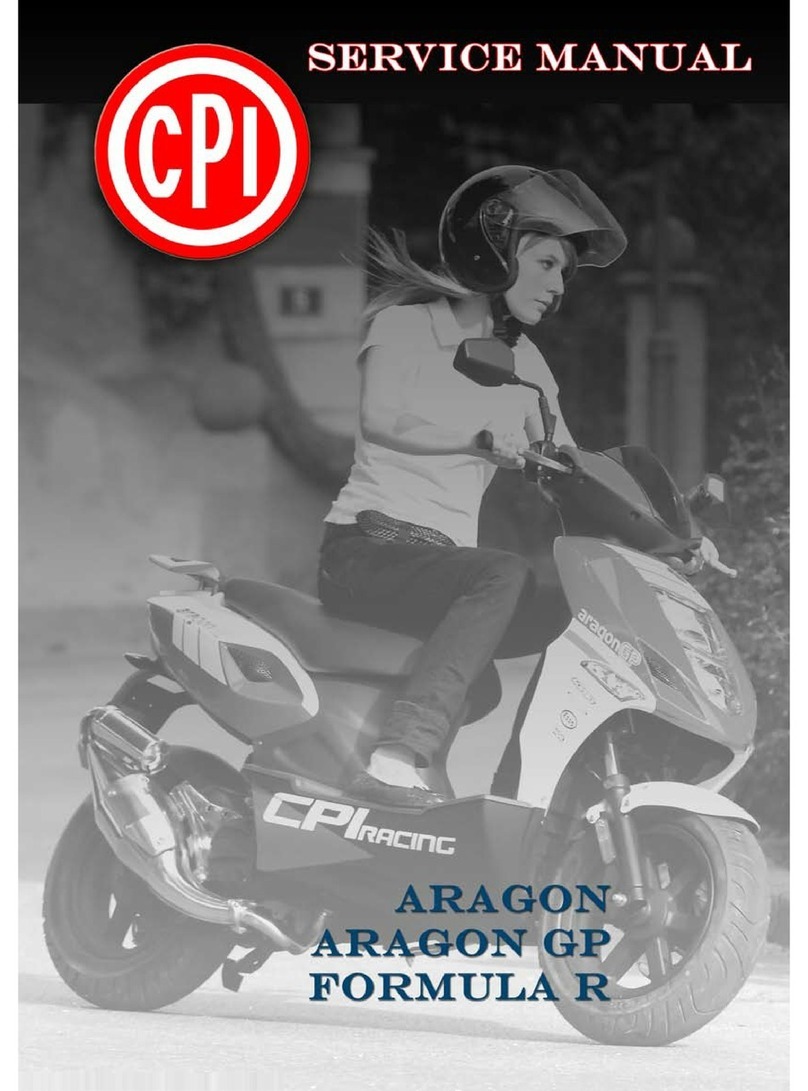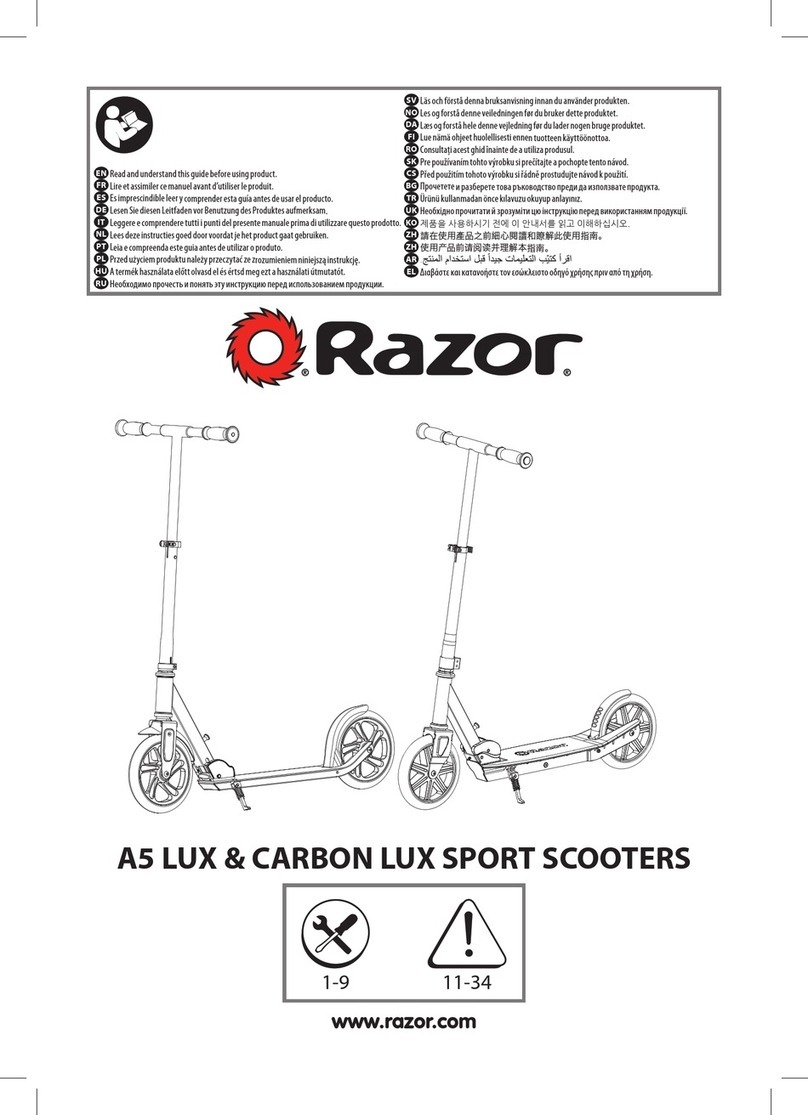Trikke eV5 User manual

TRIKKE eV5
OWNER MANUAL
Made in Holland

2TRIKKE eV5 Owner Manual March 2013
This manual has been written with great care.
However, Trikke Europe may make improvements and/or
changes to the products in this manual at any time without notice.
No portion of the text or images in this manual can be reproduced
without the prior written permission of Trikke Europe
Copyright © 2013 Trikke Europe
All Rights Reserved 2013

3TRIKKE eV5 Owner Manual March 2013
TRIKKE eV5 OWNER MANUAL
Introduction
Congratulations with your Trikke eV5!
The green, smart and easy way of personal transport over short distances.
This manual contains important information about the specics and the use of the Trikke eV5. It also provides
information about setup, inspection, operation and riding, maintenance, safety and warranty.
In case this manual is not complete or damaged or not well understood, be sure to contact your Trikke dealer or
representative to conrm you have read and understood all information completely before using your eV5.
Enjoy your ride!
Trikke Technology
The unique 3CV technology developed by Trikke Tech uses a
mechanism that allows the eV5 frame to camber and the sus-
pension to adapt to the surface and lean into turns while keep-
ing three points always in contact with the ground to ensure
optimal stability at any speed. This cambering mechanism is
elegantly simple and provides the necessary rigidity, geometry
and assistance to the rider’s motion to allow a greater control,
comfort, durability and above all the full condence of riding.
Patent & Trademark Information
The Trikke eV5 is a product developed, patented and property of
Trikke Tech, Inc. protected by the following International Patents:
U.S. 6,220,612; 6,499,751;6,827,358,;6,976,687; 1235709
Europe, Canada 2,390,224; China ZL 00 8 18040.7
Other patents pending.
TRIKKE and TRIBRED are trademarks of Trikke Tech, Inc.

4TRIKKE eV5 Owner Manual March 2013
Contact Information
Most inquiries can be addressed to the authorized dealer, distributor and service center. You can also nd addi-
tional information on our website with product information, accessories, videos, photos and more.
If you can not nd a replacement part on our website, please contact Trikke Europe via e-mail at [email protected].
Trikke Europe
Spoorlaan 5A
2495 AL The Hague
Netherlands
Phone: +31 (0) 70 3300 341
E-mail: [email protected]
Website: www.trikke-europe.com

5TRIKKE eV5 Owner Manual March 2013
Table of contents
1. The Trikke eV5
1.1 Overview ............................................................................................................................................................ 6
1.2 Specications ..................................................................................................................................................... 7
2. PreparingtheeV5foryourrstride
2.1 Unpacking the box ........................................................................................................................................ 9
2.2 Unfolding and folding the frame .................................................................................................................... 9
2.3 Mounting the handlebar ................................................................................................................................ 10
2.4 Installing the battery ....................................................................................................................................... 11
3. Operating your eV5
3.1 Pre-ride inspection ........................................................................................................................................ 12
3.2 Power on/off .................................................................................................................................................... 12
3.3 Accelerating ..................................................................................................................................................... 13
3.4 Riding .............................................................................................................................................................. 14
3.5 Taking turns ..................................................................................................................................................... 17
3.6 Slowing down/braking ................................................................................................................................... 17
3.7 Parking, locking .............................................................................................................................................. 18
3.8 Storage ............................................................................................................................................................ 19
3.9 Transport .......................................................................................................................................................... 19
4. Inspection,maintenanceandadjustments
4.1 Battery ............................................................................................................................................................. 19
4.2 Handlebar ...................................................................................................................................................... 20
4.3 Frame .............................................................................................................................................................. 21
4.4 Tires ................................................................................................................................................................. 21
4.5 Brakes .............................................................................................................................................................. 24
4.6 Fairings and skirts .......................................................................................................................................... 25
4.7 Maintenance schedule .................................................................................................................................. 26
5. Warnings,safetyinformationandridingtips................................................................................ 29
6. Warranty ....................................................................................................................................................... 33

6TRIKKE eV5 Owner Manual March 2013
1.1 Overview
handlebar
handgrip
fairing
speed switch
controller box
skirt
folding mechanism
front fork
cambering
system
front wheel
with motor
speed throttle
handgrip
stem
handlebar
height adjustment
quick release
brake lever
steering axle
battery
left arm
decks
right arm
ignition key
g. 1
Vehicle Identication Number (VIN)
Engraved in front structure underneath fairings.

7TRIKKE eV5 Owner Manual March 2013
1.2Specications
• purposes
personal transport over dry, at, hard surfaces in
forward direction
• dimensions (cm): L W H
folded: 34 71 144
unfolded: 71 127 128-140
box: 147 48 34
• weights
eV5 (naked): 18kg ???
battery: 4kg ???
eV5+battery: 22kg ???
maximum rider weight: 135kg
• speedandrange *
range at 20km/h: 35km
range at 25km/h: 25km
• materials
frame and cambering system: 6061 T6 aluminum
fairings and skirts: plastic ???
• motor
48V 350W brushless geared hub motor with
free-wheel clutch
• battery
48V 11250mAh 540Wh Li-Ion Panasonic cells
• brakes
2 x disk brake 126mm, rear wheels, dependent
(1 brake lever) or independant (2 brake levers)
• wheels
alloy rim with sealed bearings
• tires
non-marking motorcycle grade high pressure
inatable tire with inner tube
front: 10”x 2.5”
rear: 9.5”x2.5”
• charger: 54.6V 2A
• charge time: 5h
• controller: PWM 48V-22A
• speed-throttle:
1/3 twistgrip with State of Charge indicator
*
accelaration,speed and range will vary with topography,
rider’s weight, wind, riding style, tire ination. Ranges listed
above depict an average with a rider weighing 80kg.
71cm 45cm
64cm 127cm
128 - 140cm
144cm
34cm 71cm
g. 2

8TRIKKE eV5 Owner Manual March 2013

9TRIKKE eV5 Owner Manual March 2013
2. PreparingtheeV5foryourrstride
2.1 Unpacking the box
Lay the box on a at and dry surface. Lift the lid and put aside. Remove loose interior packing from the box and
take out the eV5. Remove all protection and check all contents.
The box contains: 1 x Trikke eV5 + manual 1 x battery with 2 keys + manual
1 x toolset 1 x charger
2.2 Unfolding and folding the frame
Unfolding: the folding mechanism can be found at the front of each
arm and has knob that must be pulled and twisted to keep the lock open,
to allow the folding process (g. 3).
Position the vehicle so that it is standing on its rear wheels to access and
operate the folding levers (g. 4).
Once unlocked, put the vehicle on the ground and lift the front structure.
Twist the knobs back to release the folding mechanism, allowing them
to lock in place (frame mounted) (g. 5). You should hear (and feel) two
clicks indicating the locking of each arm (g. 6).
g. 3
g. 4 g. 5 g. 6
LOCK
1
2

10 TRIKKE eV5 Owner Manual March 2013
Folding: position yourself between the two arms of the eV5 holding the front structure with one hand. With the
other hand, pull back the folding knobs on both sides into the unlocked position (g. 7). Start folding the frame
and then release the levers from the unlocked position (g. 7). Fold the frame fully by pulling the handlebar back
and down towards the platforms until the folding mechanism locks into folded position - you’ll hear (and feel) a
click for each side locking individually (g. 9).
2.3 Mounting the handlebar
The vehicle must be positioned in its standing position to mount the
handlebar. We recommend that you lock the parking brakes (see 3.7)
before putting on the handlebar to keep the vehicle stationary during
installation.
Position the handlebar with brake cables ahead (g. 10).
Note: The throttle cable is attached to the brake cable.
Loosen the two bolts on the handlebar stem with 4mm hex wrench pro-
vided. Slide the handlebar stem (with handlebar pre-attached) onto the
top of the steering post and tighten the two bolts loosely. The top bracket
should be ush with the top of the steering post (g. 11).
g. 7 g. 8 g. 9
LOCK
1
2
g. 11
g. 10

11TRIKKE eV5 Owner Manual March 2013
Aligning the handlebar
Align the handlebar perpendicular to the front wheel (or par-
allel to the axis of the front wheel) (g. 12). Once positioned,
tighten the two bolts evenly. The nal torque should be given
after the alignment is correct.
After learning to ride, you can adjust the position of the han-
dlebar (angle and height) to better suit your riding posture.
You can also adjust the angle of brake levers for comfort of
use (but do not position too far back to avoid interference
when folding the arms of your eV5). See 4.1
2.4Installingthebattery(g. 13 & 14)
Make sure the battery key is set to unlocked (OPEN) position before in-
stalling.
Slide the battery down on the rail until it sits on the tray. Do not force the
battery in an angle - make sure it will slide straight on the rail.
Turn the key clockwise to locked position (OFF) while pushing the battery
down (the battery is pre-adjusted for a tight t).
Turn the key to the next position clockwise, to turn the battery ON.
Removing the battery
Turn the key counterclockwise to OFF position. Push the key in and turn
counterclockwise again to unlock the battery. Pull the battery up by the
handle the entire extension of the rail until it’s free.
Be careful to not drop the battery on the ground during installation and
removal.
Battery can remain either installed to the eV5 or removed for charging.
g. 12
g. 14
g. 13

12 TRIKKE eV5 Owner Manual March 2013

13TRIKKE eV5 Owner Manual March 2013
3 Operating your eV5
As the eV5 is a totally new vehicle, with a unique handling, we recommend that you take time to familiarize
yourself with the vehicle and to gradually explore the limits of performance with each ride.
For the safety of friends and others who will try your new eV5 it is your responsibility to guide them how to ride
safely. Make sure you have read and understood all warnings and safety information contained in this owner’s
manual before riding. Please wear a safety helmet for riding.
3.1Pre-rideinspection
After completing the assembly process, check the vehicle again and compare it to the photograph in gure 1.
Check the battery for State Of Charge (SOC), cracks, other damage, leakage or burning (see 4.1)
Check the bolts that secure the front fork and handlebar (see 4.2). Push forward and pull back on the handlebar
strongly; this should immediately indicate if it is securely xed or not (see 4.3).
Check the folding mechanism to ensure that the arms are locked in the riding position. Use the lever lock/unlock
sticker on top of the folding mechanism as reference (see 4.3).
Check the brakes by turning the rear wheels. They should spin freely
until you apply the brakes. It must be possible to vigorously squeeze the
brake levers without the brake levers touching the handlebar (see 4.5).
Check tires for tear and wear and check pressure (see 4.4).
3.2 Power on/off
To turn power ON, turn the battery key to “ON” position (see 2.4 ) and
press the button on the throttle for 3 seconds and release.
The battery charge lights on the throttle should stay on, indicating that
the vehicle is ready for use. These lights show the estimate level of bat-
tery charge. The lights will fade as the battery charge decreases (g. 15).
There is also a state of charge (SOC) indicator on the battery cover. Press
the button the lights will show for 2 seconds indicating 0-33-66-100%
of charge level (g. 16).
To turn the eV5 OFF, turn the key to the off position or press the throttle
for 3 seconds. The indicator lights for battery charge level will turn off,
signaling that the system is off. The eV5 should be turned OFF when not
in use to prevent accidental activation of the vehicle. The eV5 will shut off
automatically after 5 minutes of inactivity.
battery life
indicators
twistspeed
throttle
on/offswitch
pushhold3seconds
g. 15
State Of Charge (SOC)
g. 16

14 TRIKKE eV5 Owner Manual March 2013
A speed limiter switch is located on the cover of the controller box. When
set to “1” (Econo), speed will be limited to 20 km/h. When set to “2”
(Express), the maximum speed is 25km/h.
The eV5 can travel faster on descents because it has a freewheel inside
the motor. Beginners should use the speed control and limit their speed
to 20 km/h or less, until they feel safe to operate at higher speeds.
3.3 Accelerating
To accelerate turn the throttle back gradually, like on a motorcycle (using
the thumb and forenger) (g. 18). The accelerator is sensitive and must
be rotated to progressively increase the torque and speed. Be careful
at the start cranking the throttle slowly until the vehicle starts to move.
Lean your body forward and force your weight onto your toes (g. 19). This
ensures the necessary weight on the front wheel, which is the traction
wheel. Once in motion, distribute your weight evenly between the front
and rear wheels. When moving, you can turn over the throttle to increase
speed and control. Avoid burning of rubber (spinning the motor freely) at
the start to not leave marks on the oor and prevent motor damage and
premature tire wear.
Avoid accelerating with the handlebar turned, since you can lose balance
and fall. Start with the front wheel aligned forward and then initiate the
turn of the handlebar once already in motion.
The eV5 can accelerate quickly, so try to ride at speeds appropriate to
your skill level and circumstances.
Crossing streets from a stand still requires well controlled acceleration.
Reducing speed (or stop) when riding at high speed, requires brake con-
trol and a safe distance.
g. 18
g. 19
2:expressmode
1: econo mode
g. 17

15TRIKKE eV5 Owner Manual March 2013
3.4 Riding
Thebasics(SwapleftandrightforUK)
eV5 riders basically have the same responsibilities as the drivers of other vehicles using the road. These responsi-
bilities are specically dened under local Trafc Laws. Make sure you are familiar with your local Trafc Laws and
regulations before using your eV5 on public roads.
eV5 riders who ride predictably, following the rules of the road and behaving like other vehicles, are likely to be
treated like regular vehicles and are also more likely to be seen by other road users. Reducing conicts among
road users reduces the risk of collisions.
Additionally every rider must master basic eV5 handling skills such as riding in straight lines, stopping, shoulder
checking and correct signaling, before venturing into trafc.
Positioning
Ride on the right side of the road, not on the left side or on the sidewalk. Riding in the wrong direction is a major
cause of vehicle collisions. Riders who drive facing trafc are vulnerable because motorists don’t expect to meet
trafc coming the wrong way.
Riding on the sidewalk is dangerous for similar reasons. Pedestrians don’t expect to meet eV5 riders. As well,
each driveway becomes a potential intersection. Local bylaws often set out the age limit or the size of vehicles
allowed to drive on sidewalks.
According to most European Trafc Laws any vehicle moving more slowly than normal trafc must drive in the
right hand lane, as close as practicable to the right edge of the road. The best position for an eV5 rider depends
on the width of the lane and the speed. eV5 riders should ride far enough from the curb, to travel in a straight line
and avoid sewer grates, potholes, debris and the doors of parked cars. If the lane is too narrow to share safely, it’s
legal to occupy the whole lane. Although courtesy should prevail, eV5 riders should not compromise their safety
for the convenience of motorists. It may be safer to take a different route. Increasingly, bike lanes are providing
a good alternative.
eV5 riders should never squeeze between moving cars and the curb.
Yieldingtocrossingtrafc
eV5 riders and motorists must decide who has the right of way at an intersection. The two rules that govern
intersection behavior are a) the driver on the minor street yields to the driver on the major street. b) If arriving
simultaneously, the driver on the left yields to the driver on the right.
Same direction yielding
When traveling in the same direction as other trafc,drivers of all vehicles (including Trikkes) must yield to trafc
already in the lane. Before changing lanes, a rider must look behind to make sure conditions are safe, signal the
lane change and negotiate with the driver behind to make sure the motorist sees the eV5 rider and agrees to let
the eV5 rider in. Lane changes should be started early, with plenty of distance between vehicles.

16 TRIKKE eV5 Owner Manual March 2013
Intersectionpositioning
At simple intersections, begin left turns from near the centerline and right turns from near the curb. In multi-
ple-lane intersections, choose the right-most lane that serves your destination. A rider should always signal and
keep out of motorists’ blind spots.
Vulnerability
Because an eV5 is smaller and more vulnerable than most other (motor) vehicles, eV5 riders must ensure that
all moves can be made safely, even if the rider has the right of way. In collisions, eV5 riders are at greater risk.
Ridingstyle
eV5 riders should drive defensively and anticipate that other road users may make errors or not see them. Some-
times, dismounting and crossing an intersection on foot is the safest solution.
Riding condently in trafc takes practice and skill. eV5 riders should wear approved safety wear (helmet) and
highly visible clothing. Your eV5 should be properly maintained, equipped with working brakes, bell or horn,
white front light and red rear lights and reectors for nighttime driving.
Rain/wetsurfaces
Avoid riding on wet or slippery surfaces (also surfaces covered by sand, gravel or mud) because the wheels may
skid and braking distance can be affected causing loss of control and a possible crash. If necessary travel on
slippery surface, try to travel in a straight line and avoid leaning the vehicle to maximize stability and control.
The eV5 can withstand a small amount of moisture, however, is not recommended for continuous use in rain or
wet. In the case the vehicle gets wet, remove the battery and keep it in a dry and ventilated environment to dry
the components. Avoid using the eV5 with wet parts. If the front wheel (motor) has been submerged, water will
get in and remain inside the motor. You will have to drain the motor by removing the drain plug and spinning the
motor off the ground. The centrifugal force will force the water out. Keep the drain hole open for several hours
preferably in the sun to remove all moisture. If water or moisture is not removed from the inside of the motor
case, the motor will be permanently damaged after some time.
Bumpyroads
Avoid impacts that can damage the motor, brackets, battery, and the frame. For example, going at speed over
potholes, bumps, curbs or any obstacles.
Uphill
When you’re climbing, it is important to assist the motor by riding in a “S” path. This is comparable to using a
lower gear to avoid overloading the motor.

17TRIKKE eV5 Owner Manual March 2013
Stuckmotorandhightemperatures
The eV5 automatically stops the power supply to the motor if the motor is stuck and cannot rotate. An example
would be to put the front wheel against a wall and press the accelerator. Another example of abuse would be
the motor stalling when climbing a steep ramp. The motor will not turn, even with the power being supplied.
This action will cause the electronic controller to disarm. Once the throttle is returned to the starting position,
the system starts working again. Avoid overloading the motor repeatedly because the electrical components will
overheat and possibly it will be damaged permanently.
Operation at very high external temperatures can cause the electronic motor controller to disarm or fail intermit-
tently. When cooled, the system will function normally again. This is a thermal protection to avoid damage to
electronic components. The controller is located inside the tower behind the battery. Do not obstruct the cooling
vents for the motor controller.
When the batteries are almost empty, there will be a pause, and intermittent power will be supplied to the motor
until the battery shuts down permanently. Battery will need to be re-charged.
3.5Takingturns
Proper use of the handlebar, and especially how to push it to the left and right is vital for your safety. Because the
front wheel is designed to trail the fork, the handlebar tends to turn in the direction you tilt the vehicle. Unlike
a bicycle, which tends to follow a straight line, the front wheel will actually accentuate the turn. Because of this
condition, less experienced riders should pay special attention while driving. Turning the handlebar too far, and
allowing the front wheel to move quickly to the side, may cause the vehicle to stop suddenly (“jack-kning”),
throwing the rider from the vehicle, which may cause injury. Always maintain rm control over the handlebar
with both hands, never drive with just one hand or no hands. The eV5 requires both hands on the handlebar at
all times.
3.6 Slowing down / braking
To brake more effectively, shift your weight back over your heels, over
the rear wheels, as shown in the picture, but be careful not to lean too
far back. Apply the brake(s) actuated by the lever on the handlebar.
Distributing your weight evenly over each rear wheel is crucial for max-
imum braking efciency. If you take the weight off of the platforms
during braking you will cause the wheel to lose contact with the ground
and lock.
The best way to ensure you are always well positioned and to minimize g. 20

18 TRIKKE eV5 Owner Manual March 2013
the risk of the vehicle pull a wheelie, is to distribute your weight evenly between the front and rear wheels, keep-
ing your weight on your toes and putting your feet up to the front of the platforms.
3.7Parking,locking
The eV5 should be turned OFF when not in use to prevent accidental activation of the vehicle. The eV5 will shut
off automatically after 5 minutes of inactivity.
The eV5 has parking brakes to keep it still and balanced. In the manual brake lever there is a pin that locks the
actuated lever (g. 21).
Squeeze the brake lever all the way and push down the lock pin with the index nger (g. 22).
Release the brake lever after pressing the pin down so that the tension of the brake lever will keep the lock-pin
triggered (g. 23). To release the brake, squeeze the brake lever and the lock- pin will jump and release from the
locked position.
Preferably, nd a at surface for parking (g. 24). If the parking spot is in an incline, point the front wheel up. Do
not park across the ramp. Try to nd a shoulder or lip to rest the front wheel against, in order to prevent unexpect-
ed movement due to the incline. Lock the parking brakes for safety.
If the above methods do not work, fold your eV5 and rest it against the wall or lay on the oor (g. 24 & 25).
To lock/secure your eV5 we recommend the use of a certied chain lock. Attach the chain through one of the rear
forks to a xed object so it can not be carried away.
Lock the battery as well or take it with you.
Only park or stall your eV5 in public environments that you know to be safe.
g. 21 g. 22 g. 23

19TRIKKE eV5 Owner Manual March 2013
3.8 Storage
When storing your eV5 for a longer period of time, take the following steps: take the battery out and store it in
a dry place at room temperature. Release pressure from the tires to 20 psi. Store the eV5 in a dry and dust free
environment, folded or unfolded, laying at or standing on the rear wheels with the front wheel resting against
a wall. Fully charge your battery every month, even when not in use. Not fully charging the battery of your eV5
once every month may result in a signicantly reduced life span or overall failure of the battery.
When you retrieve your eV5 from a longer period of storage, make sure to do a thorough pre-ride inspection
before starting to use it again (see 3.1).
3.9Transport
For transportation of your eV5 in a regular car, we recommend you take out the battery rst and put it in a safe
dry location in the car not in contact with other metal objects. Take the key out of the battery to prevent it from
breaking during transport. Good practice would be to then fold the Trikke, lock the arms and lift it in with front
wheel rst. Make sure the battery and the eV5 sit tight and will not slide or jump when the car is moving. Don’t
forget to bring your charger as well.
g. 24 g. 25 g. 26

20 TRIKKE eV5 Owner Manual March 2013
Table of contents
Other Trikke Scooter manuals

Trikke
Trikke T8 User manual
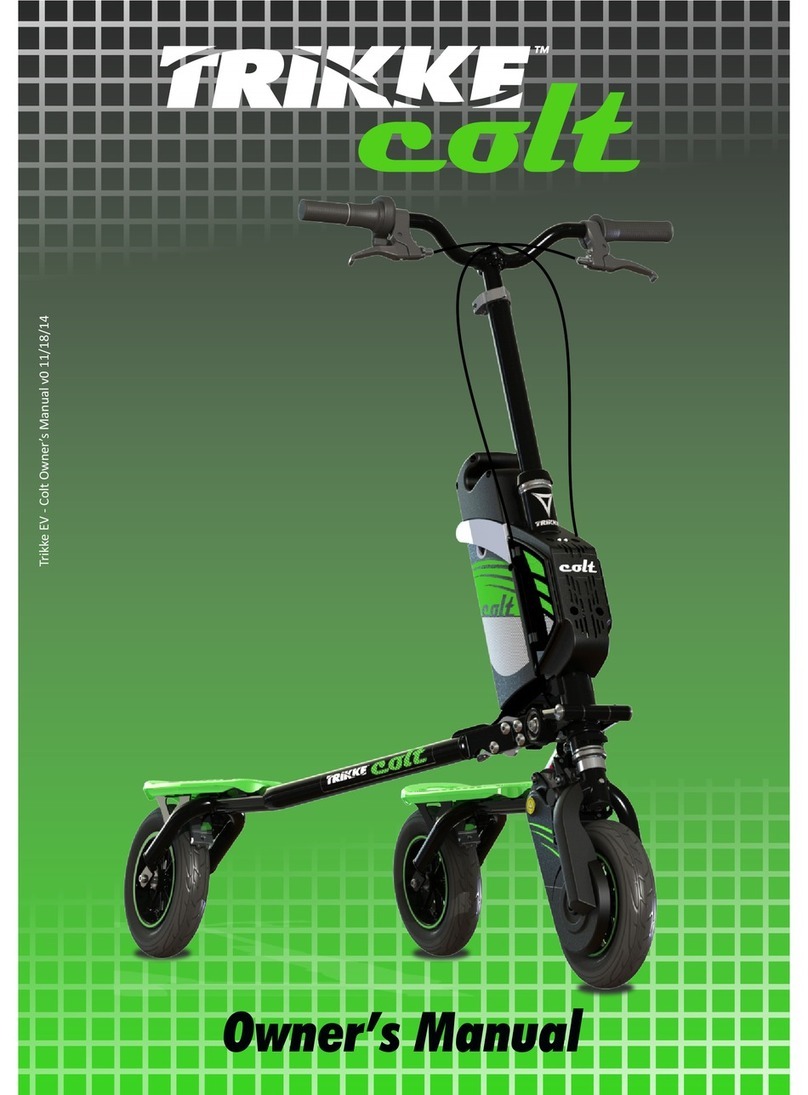
Trikke
Trikke Colt User manual
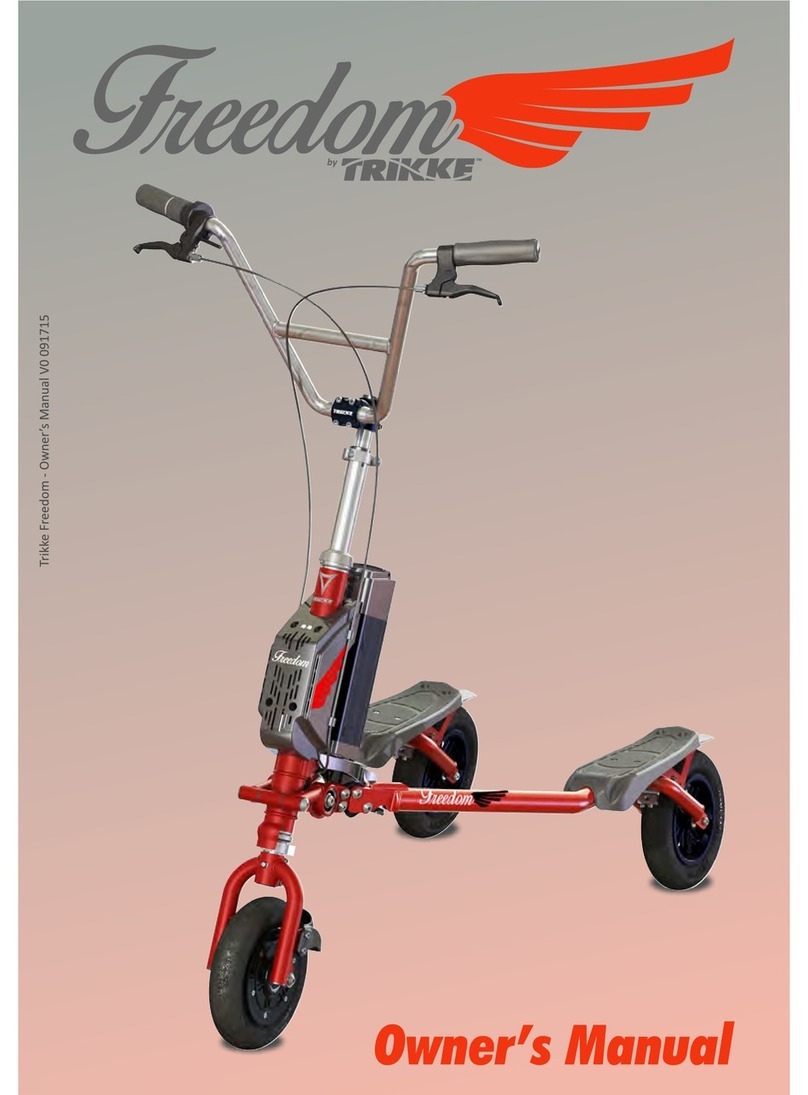
Trikke
Trikke FREEDOM User manual

Trikke
Trikke Tribred Pon-e User manual
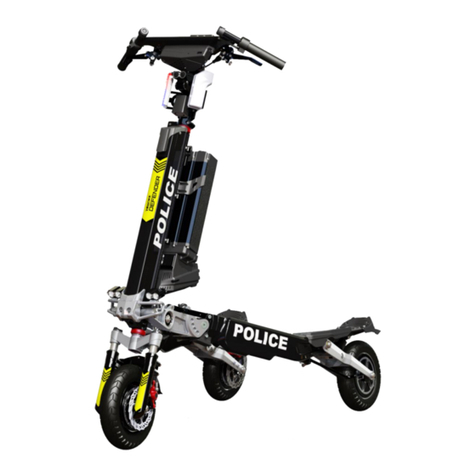
Trikke
Trikke DEFENDER User manual
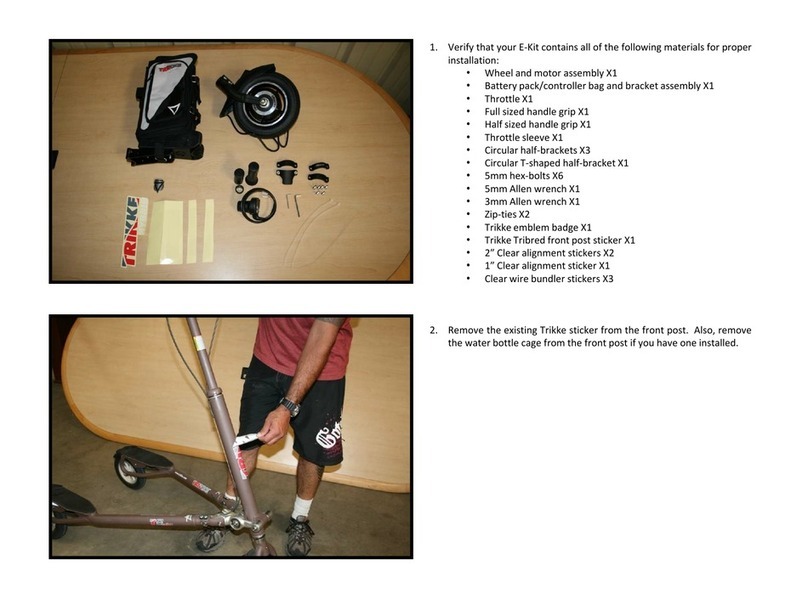
Trikke
Trikke E-Kit User manual
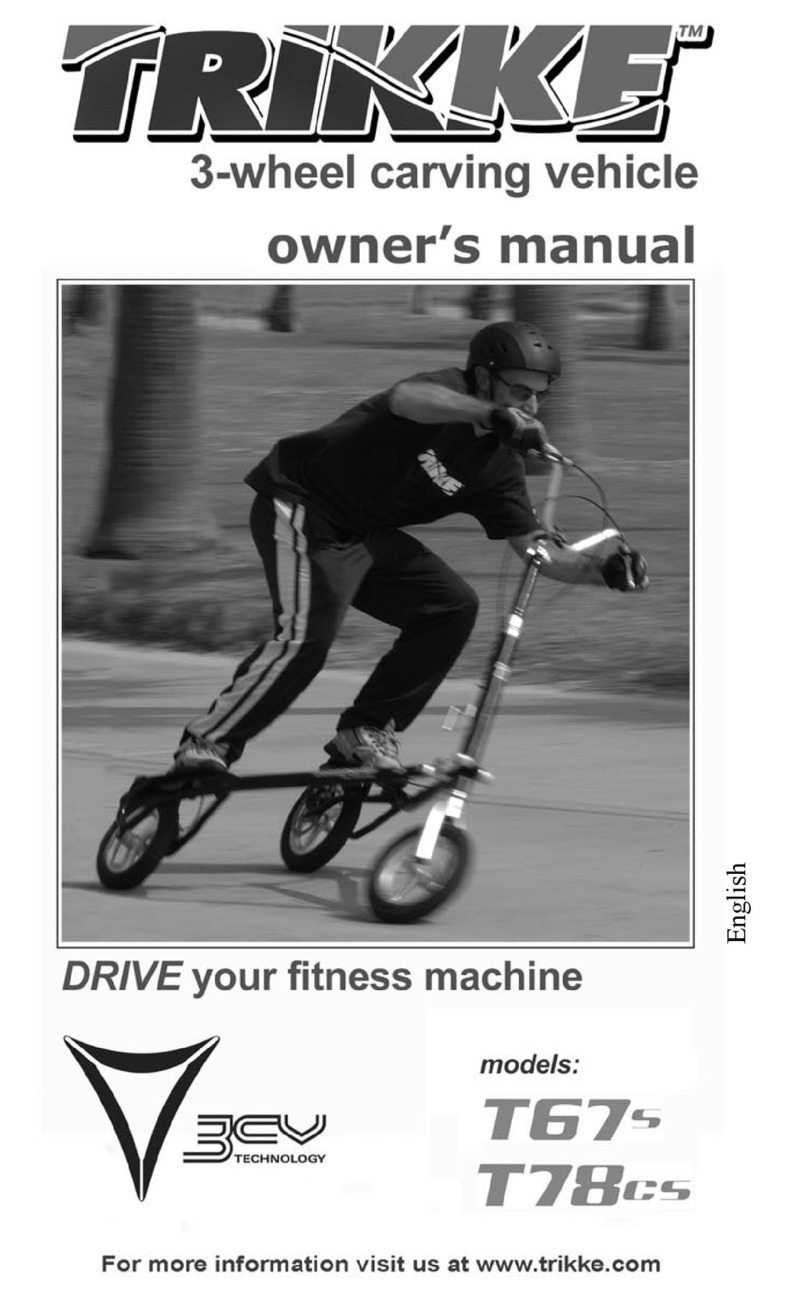
Trikke
Trikke T67s User manual
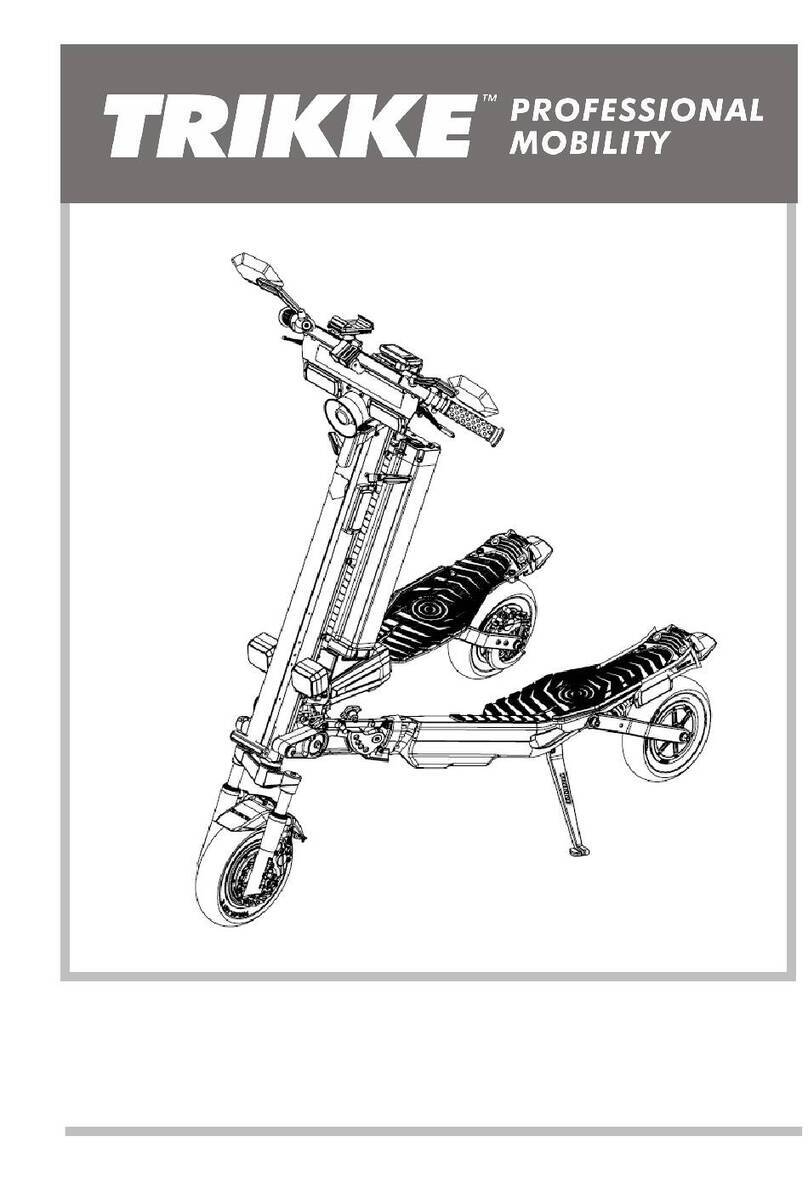
Trikke
Trikke DEFENDER 48V 2WD User manual
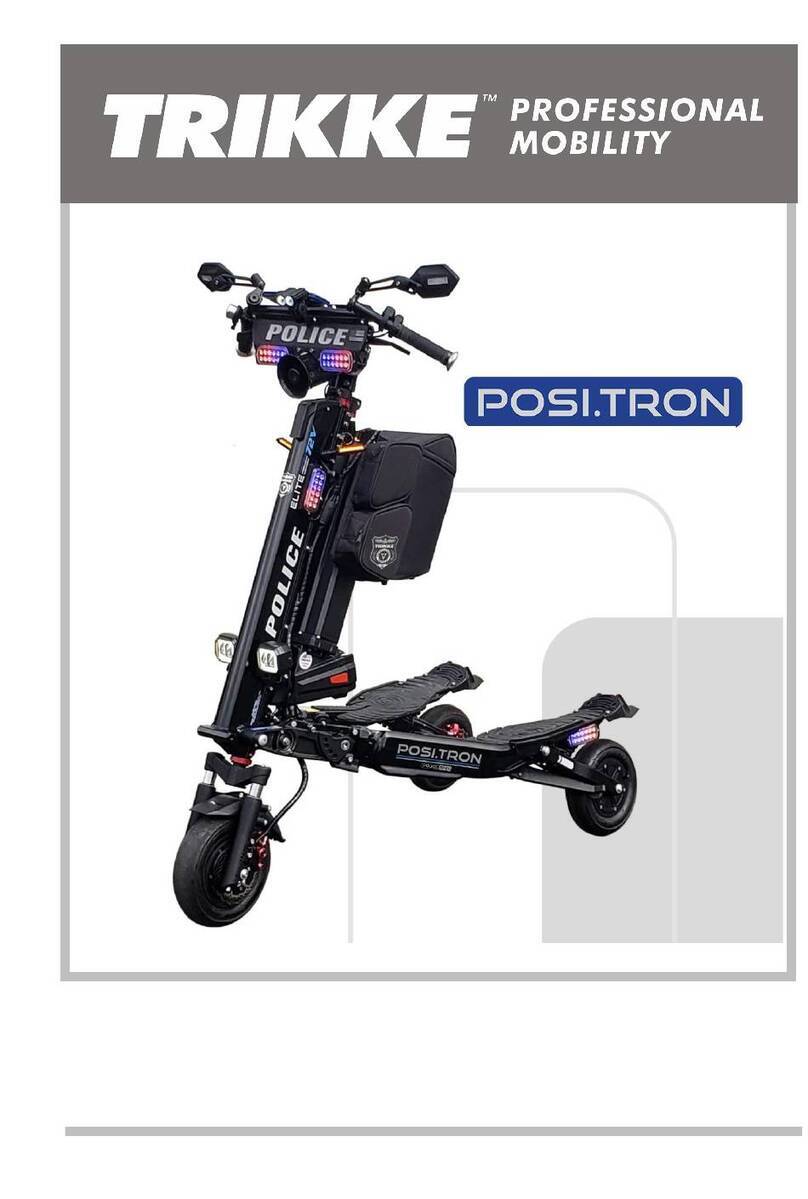
Trikke
Trikke POSITRON 60V AWD User manual

Trikke
Trikke uPT User manual

